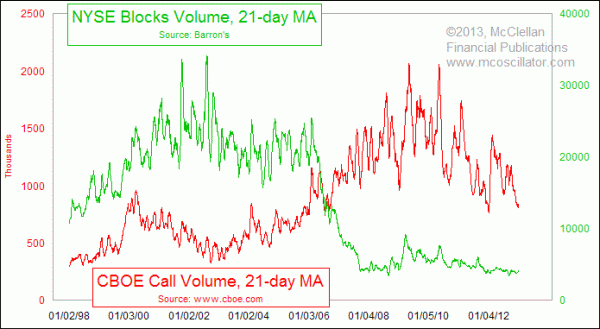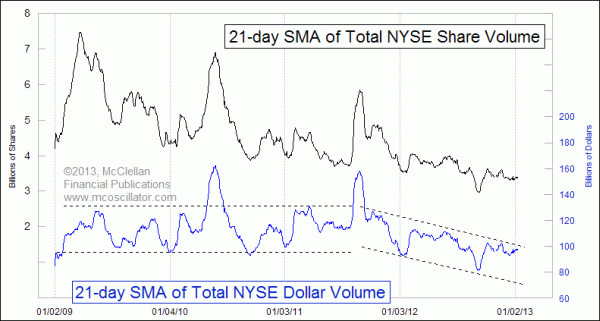The Disappearing Volume

Free Chart In Focus email
Delivered to you every week
It is time to review some ancient stock market jargon, in order to understand the principle of the disappearing market volume.
A "lot" is 100 shares of stock. In the era of specialists controlling trading on the floor of the NYSE, trading was done much more easily in "round lots", meaning multiples of 100 shares which the specialist could apportion out to other traders, much like how an air traffic controller directs multiple inbound and outbound aircraft in the same airspace. In the days before computers and calculators, putting transactions in round lots made things easier; figuring out how much money had to change hands for a stock at $93/share is much easier if the quantity is 100 shares. That's easy math: $9300. It gets harder if the multiple is different than 100.
"Odd lots" means anything other than a round lot, and in the old days, odd lot orders would go to the "odd lot desk" in order to get aggregated with others into round lots, or otherwise married up with a corresponding opposing order or acceptance.
In the days of paper order slips, order ledgers, and share certificate clerks running paper back and forth across lower Manhattan, these were important functions. Now that computers move bits around and actual certificates stay in place (or are imaginary), these ideas seem antiquated. Why should it matter whether a trade is 200 shares or 43? The computer does not care, and it does not have trouble doing the math of things that get multiplied by some number other than 100.
When you step up to the big leagues of trading, a "block" is any trade of 10,000 shares or more that is done all at once. Block trades used to be how the big institutions would move money around without bothering to mix with the commoners who traded round lots or (ick!) odd lots.
Back in those old days, it was tremendous fun to compare the number of block trades to the odd lot trades, and even to look at odd lot shorts. That way, an analyst could evaluate what the big guys were doing versus what the little (presumably clueless) traders were doing. It was fun while it lasted.
The advent of computerized trading algorithms changed all of that. Nowadays, you can have a computer break up a block trade into multiple odd lots, thereby disguising what the big institution is doing and hopefully preventing other traders from sniffing out a big move and trying to front run it. So the whole idea of little guys trading in odd lots and big guys trading in blocks has been thrown out the window. That helps to explain why the total volume of block trades is now down to a small fraction of what it used to be.
But that is not the whole explanation, which is (finally!) what this week's chart is all about. The migration out of block trades has not just been to smaller denominations of share volume, but off the exchange entirely. If a major institution wants to move big money into or out of a stock, it does not necessarily need to trade the actual shares. One option controls 100 shares of a company's stock, and so 100 call options does the equivalent of what a block trade meant in the old days.
I had a question posed to me this week by a colleague named Greg Adams, who is the Chief Investment Strategist for Allen, Mooney, & Barnes, a money management firm. Greg had noticed that total daily volume has been shrinking in a lot of the stocks that he and his firm are accustomed to following, and the upshot of this is that his ability to trade full blocks of shares like he used to has gone away. Greg hypothesized that the major institutions which formerly traded the blocks in the old days had migrated away, and that the trading may still be taking place but in the options market instead of the regular stock market.
The chart above supports that hypothesis in a big way, or at least it did up until the past couple of years. The big drop in block trades from 2006-2008 matched a corresponding rise in call option trading, as if the activity was migrating from one part of the market to another. For big institutions, the attraction of options is obvious: Why buy the stock when you can rent the potential price appreciation for a small option premium, and in the process conceal from other traders what you and your gigantic portfolio are doing?
So the idea that trading was migrating from blocks to options made sense for a while, but it makes less sense lately. Both the total call volume and the blocks volume are now near multi-year lows. The chart above shows 21-day moving averages, smoothing out the fluctuations over the period of about a month.
Interestingly, both block volume and call option volume were on the rise in the late 1990s, when the Internet bubble and the Baby Boom population reaching peak earning years worked together to bring more money to the market. During the 2000s, they seem to have moved in opposite directions, as the rising tide was no longer lifting all boats, and it became a fight over dwindling market share.
Now both markets are evidently shrinking, as the Baby Boom generation starts to enter retirement mode in earnest, and as the stock market's movements are driven to a larger extent by whatever the Fed wants to do to manipulate things. That shrinkage in blocks and in call options matches a drop in overall volume over the past couple of years.

In terms of both share volume and dollar volume, trading activity has been shrinking pretty dramatically since the second half of 2011. We calculate dollar volume ourselves, using data published by the NYSE on the composite trading of all its listed stocks (not just floor volume). We multiply the closing price by total daily volume, and then smooth it with a 21-day simple moving average for display in this chart. That's not quite perfectly accurate, since not all of a stock's trading is at the closing price. But it is a good enough approximation.
Share volume has been shrinking for a lot longer, but the explanation for that is understandable. Companies are not splitting their stock now as much as they did in years past, following the model of Berkshire Hathaway and just letting the price continue to go up as the stock appreciates. That's why looking at dollar volume helps us see that up until 2011, trading activity was remaining about the same as it had been.
But over the past year and a half, there is a distinct change in all of these volume measures. Part of that may be due to the implementation of the Volcker Rule, prohibiting banks from doing short term proprietary trading for their own accounts. The collapse of MF Global (and Bear Stearns, and Lehman) also takes away some of the prior levels of trading activity.
The point to take from this for individual traders is that we are in an environment of shrinking volume all across the market, and so that should be taken into account when interpreting volume figures for technical analysis purposes. It also increases the likelihood of a Flash Crash type illiquidity event, if there is not as big of a background level of trading to absorb any ripples or turbulence. As with the Flash Crash, which unfolded right after the end of QE1, we should see those illiquidity events more frequently once the Fed starts to pull back on all the extra money it is throwing at the banking system.
Tom McClellan
Editor, The McClellan Market Report
Aug 24, 2012
Total Dollar Volume Not So Bad |
Dec 20, 2012
Steep Yield Curve Does Not Offer Complete Immunity |
Jul 20, 2012
GE’s Share Price Has Message For Market |